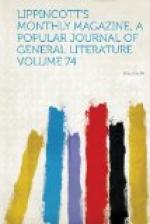[Illustration: TURKISH LADY.]
We embarked with our baggage in a caique, which is much like an open gondola, only lighter and narrower, and generally painted in light colors, yellow being the favorite one, and were soon landed at the custom-house. A franc satisfied the Turk in attendance that our baggage was all right, and it was immediately transferred to the back of an ammale, or carrier. These men take the places of horses and carts with us. A sort of pack-saddle is fastened on their backs, and the weights they carry are astonishing. Our ammale picked up a medium-sized trunk as if it was a mere feather: on top of this was put a hat-box, and with a bag in one hand he marched briskly off as if only enjoying a morning constitutional. We made our way through the dirty streets and narrow alleys to the Hotel de Byzance in the European quarter. This is a very comfortable hotel, kept in French style, and most of the attendants speak French. Our chamber_maid_, however, is a man, a most remarkable old specimen in a Turco-Greek dress—long blue stockings and Turkish slippers, very baggy white trousers, a blue jacket, white turban twisted around his fez cap and a voluminous shawl about his waist. His long moustache is quite gray, but his black eyes are keen as a hawk’s, and as he moves quickly and silently about my room, arranging and dusting, I fancy how he would look in the same capacity in our house at home.
Our hotel stands in the Rue de Pera, the principal street of the European quarter, and as it is narrow the lights from the shops make it safe and agreeable to walk out in the evening. This is one of the few streets accessible to carriages, though in some parts it is difficult for two to pass each other. Most of the shops are French and display Paris finery, but the most attractive are the fruit-shops with their open fronts, so you take in their inviting contents at a glance. Broad low counters occupy most of the floor, with a narrow passage leading between from the street to the back part of the shop, and counters and shelves are covered with tempting fruits and nuts. Orange boughs with the fruit on decorate the front and ceiling of the shop, and over all presides a venerable Turk. In the evening the shop is lighted by a torch, which blazes and smokes and gives a still more picturesque appearance to the proprietor and his surroundings. You stand in the street and make your purchases, looking well to your bargains, for the old fellow, with all his dignity, will not hesitate to cheat a “dog of a Christian” if he can. From every dark alley as we walked along several dogs would rush out, bark violently, and after following us a little way slink back to their own quarter again. Each alley and street of the city has its pack of dogs, and none venture on the domain of their neighbors. During the day they sleep, lying about the streets so stupid that they will hardly move; in fact, horses and donkeys step over them, and pedestrians wisely let them alone. After dark they prowl about, and are the only scavengers of the city, all garbage being thrown into the streets. The dogs of Pera have experienced, I suppose, the civilizing effects of constant contact with Europeans, as they are not at all as fierce as those of Stamboul. They soon learn to know the residents of their own streets and vicinity, and bark only at strangers.




